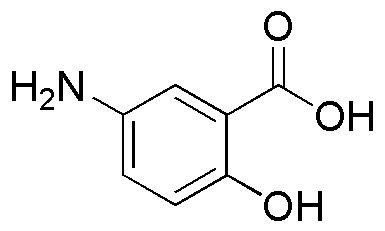5-Aminosalicylic acid is widely utilized in research focused on:
- Pharmaceutical Development: This compound is primarily used in the formulation of medications for treating inflammatory bowel diseases, particularly ulcerative colitis. Its effectiveness in reducing inflammation makes it a vital ingredient in therapeutic drugs.
- Analytical Chemistry: It serves as a standard in various analytical methods, helping researchers quantify and analyze similar compounds in complex mixtures. This is crucial for ensuring the accuracy of experimental results.
- Biochemical Research: The compound is employed in studies investigating the mechanisms of action of anti-inflammatory agents, providing insights that can lead to the development of new treatments.
- Cosmetic Formulations: Due to its anti-inflammatory properties, it is also used in skincare products aimed at reducing redness and irritation, making it beneficial for sensitive skin formulations.
- Food Industry: It can be utilized as a food additive for its antioxidant properties, helping to preserve food quality and enhance shelf life, which is increasingly important in food safety and preservation.
General Information
Properties
Safety and Regulations
Applications
5-Aminosalicylic acid is widely utilized in research focused on:
- Pharmaceutical Development: This compound is primarily used in the formulation of medications for treating inflammatory bowel diseases, particularly ulcerative colitis. Its effectiveness in reducing inflammation makes it a vital ingredient in therapeutic drugs.
- Analytical Chemistry: It serves as a standard in various analytical methods, helping researchers quantify and analyze similar compounds in complex mixtures. This is crucial for ensuring the accuracy of experimental results.
- Biochemical Research: The compound is employed in studies investigating the mechanisms of action of anti-inflammatory agents, providing insights that can lead to the development of new treatments.
- Cosmetic Formulations: Due to its anti-inflammatory properties, it is also used in skincare products aimed at reducing redness and irritation, making it beneficial for sensitive skin formulations.
- Food Industry: It can be utilized as a food additive for its antioxidant properties, helping to preserve food quality and enhance shelf life, which is increasingly important in food safety and preservation.
Documents
Safety Data Sheets (SDS)
The SDS provides comprehensive safety information on handling, storage, and disposal of the product.
Product Specification (PS)
The PS provides a comprehensive breakdown of the product’s properties, including chemical composition, physical state, purity, and storage requirements. It also details acceptable quality ranges and the product's intended applications.
Certificates of Analysis (COA)
Search for Certificates of Analysis (COA) by entering the products Lot Number. Lot and Batch Numbers can be found on a product’s label following the words ‘Lot’ or ‘Batch’.
*Catalog Number
*Lot Number
Certificates Of Origin (COO)
This COO confirms the country where the product was manufactured, and also details the materials and components used in it and whether it is derived from natural, synthetic, or other specific sources. This certificate may be required for customs, trade, and regulatory compliance.
*Catalog Number
*Lot Number
Safety Data Sheets (SDS)
The SDS provides comprehensive safety information on handling, storage, and disposal of the product.
DownloadProduct Specification (PS)
The PS provides a comprehensive breakdown of the product’s properties, including chemical composition, physical state, purity, and storage requirements. It also details acceptable quality ranges and the product's intended applications.
DownloadCertificates of Analysis (COA)
Search for Certificates of Analysis (COA) by entering the products Lot Number. Lot and Batch Numbers can be found on a product’s label following the words ‘Lot’ or ‘Batch’.
*Catalog Number
*Lot Number
Certificates Of Origin (COO)
This COO confirms the country where the product was manufactured, and also details the materials and components used in it and whether it is derived from natural, synthetic, or other specific sources. This certificate may be required for customs, trade, and regulatory compliance.


